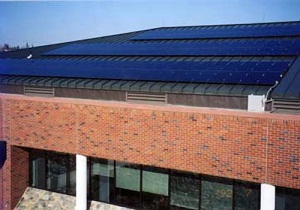Traverse City Light & Power investigating community solar project
 Traverse City Light & Power, a municipally-owned utility in Michigan, plans to install a 50 kilowatt (kW) community solar project in 2011. The utility is working on how best to finance the project.
Traverse City Light & Power, a municipally-owned utility in Michigan, plans to install a 50 kilowatt (kW) community solar project in 2011. The utility is working on how best to finance the project.
The capacity of the project would only account for about half a percent of the electricity produced by Traverse City Light & Power, reported The Traverse City Record Eagle. Still, the utility will soon get more than 10 percent of its power from renewable sources, including power from a wind farm, a 600 kW wind turbine and landfill gas purchases.
Before the utility can start constructing the $500,000, 50 kW project at its Hastings facility, it must decide how best to allow the community to buy into the project.
“It’s a matter of designing the program to meet the needs [of our consumers],” said Jessica Wheaton, Traverse City Light & Power spokesperson. “It’s something we definitely want to do. It’s something our board and staff are excited about.”
The utility already has been testing photovoltaic panels at its Hastings complex, according to Wheaton.
“We have four test panels on the site,” she said. “We’ve been testing them for a year and a half now.” She added that the utility has been analyzing which panels will be the most efficient in Traverse City, including one two-sided panel.
At present, the utility is looking at financing the project.
“We could look for grants, but right now we’re looking at having Light & Power fund the up-front costs and having people buy into it with a monthly tariff,” Wheaton said.
The city previously offered such a green tariff to finance the installation of the community-owned turbine.
“It was paid off,” Wheaton said. “We dissolved the green rate last year and are looking into making everyone pay the green rate as part of their normal bill.” However, customers could still opt into buying the power produced by the PV array—separately from their normal bill.
Another option would be for community members to buy a panel and then receive reimbursement based on the panel’s generation.
According to the utility, other such projects around the country have included an up-front payment by a customer of $1,000 to $2,000, in order to buy part of a solar array, or a monthly fee instead of an up-front payment. Construction on the project should begin in spring 2011.
“It could be a little before, could be a little after,” said Wheaton. She said weather is definitely a factor in terms of installing a system in the region.
Image courtesy of NREL.



